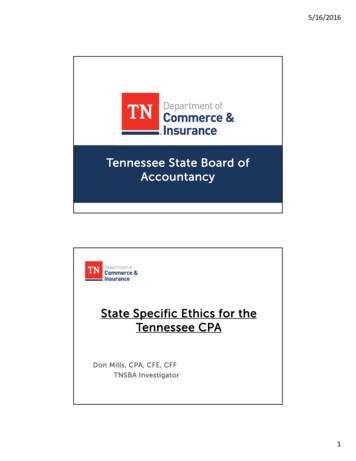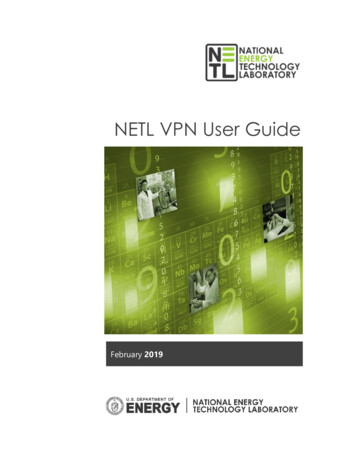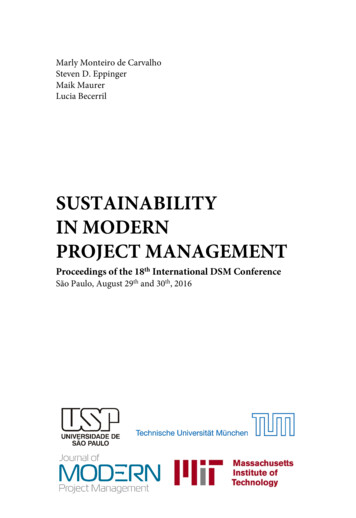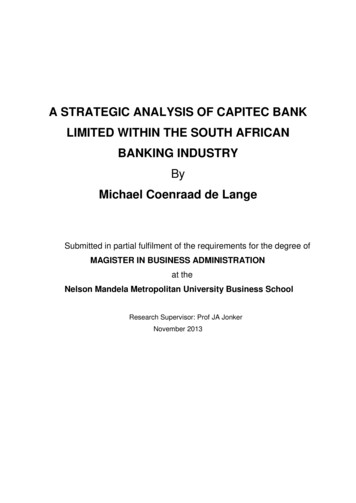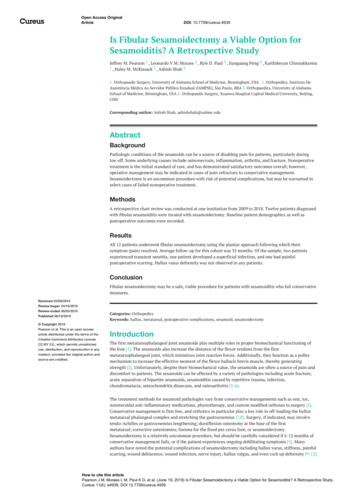
Transcription
Open Access OriginalArticleDOI: 10.7759/cureus.4939Is Fibular Sesamoidectomy a Viable Option forSesamoiditis? A Retrospective StudyJeffrey M. Pearson 1 , Leonardo V M. Moraes 2 , Kyle D. Paul 3 , Jianguang Peng 4 , Karthikeyan Chinnakkannu1 , Haley M. McKissack 3 , Ashish Shah 31. Orthopaedic Surgery, University of Alabama School of Medicine, Birmingham, USA 2. Orthopedics, Instituto DeAssistência Médica Ao Servidor Público Estadual (IAMPSE), São Paulo, BRA 3. Orthopaedics, University of AlabamaSchool of Medicine, Birmingham, USA 4. Orthopaedic Surgery, Xuanwu Hospital Capital Medical University, Beijing,CHNCorresponding author: Ashish Shah, ashishshah@uabmc.eduAbstractBackgroundPathologic conditions of the sesamoids can be a source of disabling pain for patients, particularly duringtoe-off. Some underlying causes include osteonecrosis, inflammation, arthritis, and fracture. Nonoperativetreatment is the initial standard of care, and has demonstrated satisfactory outcomes overall; however,operative management may be indicated in cases of pain refractory to conservative management.Sesamoidectomy is an uncommon procedure with risk of potential complications, but may be warranted inselect cases of failed nonoperative treatment.MethodsA retrospective chart review was conducted at one institution from 2009 to 2018. Twelve patients diagnosedwith fibular sesamoiditis were treated with sesamoidectomy. Baseline patient demographics as well aspostoperative outcomes were recorded.ResultsAll 12 patients underwent fibular sesamoidectomy using the plantar approach following which theirsymptom (pain) resolved. Average follow-up for this cohort was 35 months. Of the sample, two patientsexperienced transient neuritis, one patient developed a superficial infection, and one had painfulpostoperative scarring. Hallux varus deformity was not observed in any patients.ConclusionFibular sesamoidectomy may be a safe, viable procedure for patients with sesamoiditis who fail conservativemeasures.Received 04/09/2019Review began 04/16/2019Review ended 06/05/2019Categories: OrthopedicsKeywords: hallux, metatarsal, postoperative complications, sesamoid, sesamoidectomyPublished 06/19/2019 Copyright 2019Pearson et al. This is an open accessarticle distributed under the terms of theCreative Commons Attribution LicenseCC-BY 3.0., which permits unrestricteduse, distribution, and reproduction in anymedium, provided the original author andsource are credited.IntroductionThe first metatarsophalangeal joint sesamoids play multiple roles in proper biomechanical functioning ofthe foot [1]. The sesamoids also increase the distance of the flexor tendons from the firstmetatarsophalangeal joint, which minimizes joint reaction forces. Additionally, they function as a pulleymechanism to increase the effective moment of the flexor hallucis brevis muscle, thereby generatingstrength [2]. Unfortunately, despite their biomechanical value, the sesamoids are often a source of pain anddiscomfort to patients. The sesamoids can be affected by a variety of pathologies including acute fracture,acute separation of bipartite sesamoids, sesamoiditis caused by repetitive trauma, infection,chondromalacia, osteochondritis dissecans, and osteoarthritis [3-6].The treatment methods for sesamoid pathologies vary from conservative managements such as rest, ice,nonsteroidal anti-inflammatory medications, physiotherapy, and custom modified orthoses to surgery [3].Conservative management is first line, and orthotics in particular play a key role in off-loading the halluxmetatarsal phalangeal complex and stretching the gastrocnemius [7,8]. Surgery, if indicated, may involvetendo-Achilles or gastrocnemius lengthening; dorsiflexion osteotomy at the base of the firstmetatarsal; corrective osteotomies; fusions for the fixed pes cavus foot; or sesamoidectomy.Sesamoidectomy is a relatively uncommon procedure, but should be carefully considered if 6-12 months ofconservative management fails, or if the patient experiences ongoing debilitating symptoms [5]. Manyauthors have noted the potential complications of sesamoidectomy including hallux varus, stiffness, painfulscarring, wound dehiscence, wound infection, nerve injury, hallux valgus, and even cock up deformity [9-12].How to cite this articlePearson J M, Moraes L M, Paul K D, et al. (June 19, 2019) Is Fibular Sesamoidectomy a Viable Option for Sesamoiditis? A Retrospective Study.Cureus 11(6): e4939. DOI 10.7759/cureus.4939
Despite this, sesamoidectomy still remains a plausible treatment for cases of chronic sesamoidal pain inpatients who have failed nonoperative treatment [13-15].We present a series of patients who underwent fibular sesamoidectomy for intractable sesamoiditis thatfailed conservative measures. The purpose of this study was to evaluate the postoperative clinical outcomesand complications of this procedure. We hypothesize that fibular sesamoidectomy is a safe, effectivetreatment with few complications when properly performed in select cases.Materials And MethodsAfter approval from our institutional review board, a retrospective chart review was performed from 2009 to2018. Billing codes were reviewed, and all patients with a diagnosis of fibular sesamoiditis were identifiedwith ICD-10 code M86.6. The cohort was further stratified based on operative intervention with fibularsesamoidectomy using the Current Procedural Terminology (CPT) code 28315.A total of 12 patients met our criteria. We obtained demographic information including age, gender, bodymass index (BMI), laterality, tobacco use, occupation, duration of conservative management, andcomorbidities. In July 2018, all patients were contacted to complete the foot function index (FFI) via phoneas well [15]. One patient who had rheumatoid arthritis (RA) was deceased, and four patients did not fill outthe questionnaire.According to preoperative images, two patients had hallux valgus and hallux rigidus. Of these two patients,one also had preexisting rheumatoid arthritis. Both the patients who had hallux valgus along with rigidusdid not reply to our questionnaire. One patient in the cohort had isolated hallux rigidus with sesamoiditis.Seven of 12 patients completed the FFI for functional evaluation. Postoperative information collectedincluded any evidence of infection, neuritis, return to operating room (OR), and postoperative deviation ofthe hallux. Any other postoperative complications, as well as total length follow-up, were recorded for eachpatient.All patients were initially treated for an extended period with conservative measures. This includedorthotics, anti-inflammatory medications, physical therapy, limitation of activity, and a trial of non-weightbearing. Despite these measures, symptoms persisted for these 12 patients. All patients underwent fibularsesamoidectomy for their symptoms.The fibular sesamoidectomy procedure was performed by any one of three fellowship-trained foot and anklesurgeons. All surgeons used the plantar approach with a longitudinal incision on the lateral edge of the firstmetatarsal fat pad. Care was taken to ensure that the lateral plantar digital nerve was protected during theprocedure (Figure 1). The metatarsal fat pad was retracted medially with the lateral plantar digital branch ofthe hallux, a branch of the medial plantar nerve. The lateral sesamoid was then isolated and shelled out witha beaver blade (Figure 2). The tendon of the flexor hallucis longus was inspected to ensure its continuity.The plantar plate was closed carefully to minimize postoperative great toe deviation (Figures 3-5). The skinwas approximated with nonabsorbable sutures, avoiding placement of subcutaneous nonabsorbable suturematerial beneath the plantar skin. The foot was placed in bunion-type wound dressing with the hallux heldin slight plantar flexion. Postoperatively, patients were kept non-weight bearing for two weeks, and werekept in a post-op walking shoe for six weeks total. Sutures were removed at two weeks postoperatively.2019 Pearson et al. Cureus 11(6): e4939. DOI 10.7759/cureus.49392 of 9
FIGURE 1: Plantar incision with isolated plantar digital nerve (blackarrow)FIGURE 2: Lateral sesamoid excision2019 Pearson et al. Cureus 11(6): e4939. DOI 10.7759/cureus.49393 of 9
FIGURE 3: Intraoperative image after sesamoid excisionFIGURE 4: Plantar plate defect after sesamoid excision2019 Pearson et al. Cureus 11(6): e4939. DOI 10.7759/cureus.49394 of 9
FIGURE 5: Plantar plate repairResultsPreoperative patient baseline demographics can be found in Table 1. Of our 12 patients, the average age was38 years. Ten of 12 patients (83%) were female, while two were male. The patients’ average BMI was 23.58.The majority of the patients (10) had no history of trauma, and two referred forefoot injury in the past.2019 Pearson et al. Cureus 11(6): e4939. DOI 10.7759/cureus.49395 of 9
CharacteristicNumber of PatientsAverage age (years)37.58GenderFemale10Male2Average BMI23.58Side of surgeryRight8Left4Tobacco use1History of trauma2ComorbiditiesRheumatoid arthritis1Diabetes1TABLE 1: Baseline patient demographicsBMI: Body mass indexPreoperative findings are shown in Table 2. According to preoperative images, two patients had both halluxvalgus and hallux rigidus. One patient had preexisting rheumatoid arthritis with involvement of the firstmetatarsophalangeal (MTP) joint. Five of 12 (42%) patients had avascular necrosis of the sesamoid, based onmagnetic resonance imaging (MRI).FindingNumber of PatientsPreoperative X-raysHallux rigidus3 (2 with concurrent hallux valgus)Hallux valgus2 (both with concurrent hallux rigidus; one with concurrent RA)Preoperative exam findingsCavus foot3Previous sesamoid fracture2MRI findingsAVN of sesamoid5Chronic changes1TABLE 2: Preoperative findingsAVN: Avascular necrosis; RA: Rheumatoid arthritis.The average follow-up for the cohort was 35 months. No patients developed cock-up deformity of the lessertoes or hallux varus deformity either clinically or radiologically. Of the 12, two patients developed transientneuritis postoperatively, one developed a painful scar, and one developed a superficial infection. Among theseven patients who responded to the FFI questionnaire, the average score was 8.3. No patients requiredreoperation (Table 3).2019 Pearson et al. Cureus 11(6): e4939. DOI 10.7759/cureus.49396 of 9
PatientNumberGenderAgeBMIComorbiditiesOther Foot cationFFIIsolated fibular ANoNoNoNo3.94F3018.88NoNoNoTransient neuritisN/A5F3630.41NoNoNoTransient neuritis106F4322.67NoNoYesPainful 924.7NoNoNoNo21.7YesNoNoN/ASesamoiditis with hallux rigidusHallux valgus, first MTP10F59N/ARA11F3323.57NoHallux valgus with rigidusNoNoSuperficial BLE 3: Patient characteristics and postoperative outcomesDM: Diabetes mellitus; RA: Rheumatoid arthritis; MTP: Metatarsophalangeal; BMI: Body mass index; FFI: Foot function index.DiscussionLateral sesamoidectomy is indicated when conservative management for sesamoiditis fails. Sesamoiditis is abroad term referring to conditions causing pain of the seasamoids, including avascular necrosis, overloading,chondromalacia, and fracture. In contrast to early studies, which report sesamoidectomy to be associatedwith high incidence of complications (particularly hallux varus), recent literature suggests improvedoutcomes [11,13,16,17]. However, most of these reports focus on combinations of medial, lateral, and pairedexcision, rather than lateral excision alone, making this one of the few reports in the literature that assessesoperative outcomes of isolated fibular sesamoidectomy. Additionally, it includes one of the largest cohortsof isolated fibular sesamoidectomy for lateral insidious sesamoiditis to date, and is the first study to ourknowledge which reports midterm follow-up results with a cohort of this size.It is important to assess outcomes of isolated lateral sesamoidectomy, as this procedure has an increasedlikelihood of complications when compared to medial and paired excision. In a previous study by Kane etal., complication rates were found to be greater in lateral sesamoidectomy (41.2%) (seven of 17 patients)than in medial sesamoidectomy (22.2%) (four of 18 patients) [18]. Although these rates were not statisticallysignificantly different, this may be due to small sample size, and does not necessarily reflect their clinicalsignificance. Complications reported in the literature after sesamoidectomy include impaired range ofmotion, continued pain, neuroma development, transient neuritis, and deformities [19,20]. One patient inour study developed a superficial infection, which was successfully treated with oral antibiotics. No cases ofneuroma occurred in our cohort, and two instances of neuritis were found which resolved with pregabalin.The results of our study yielded a lower incidence of neurological complications compared to other studiesassessing operative outcomes in lateral sesamoidectomy.Incidence of deformity was found to be lower in the current study than in previous reports documentingoutcomes of lateral sesamoidectomy [16]. Hallux varus deformity is a potential consequence of weaknessand instability at the first MTP joint, which may occur if the integrity of the flexor hallucis brevis (FHB),adductor hallucis tendons, or capsular structures is not maintained or restored [5]. Mann and Coughlinreported an 8% incidence of hallux varus after sesamoidectomy using the plantar approach [16]. In our study,after an average of 35 months postoperative follow-up, no patients developed cock up deformity, halluxvarus, or hallux valgus. These results are comparable to outcomes reported by Milia et al. [13]. We believethat repairing the plantar plate and maintaining the continuity of FHB is crucial in preventing theoccurrence of hallux varus deformity. Three patients in this series underwent concurrent plantar plate repair2019 Pearson et al. Cureus 11(6): e4939. DOI 10.7759/cureus.49397 of 9
during the lateral sesamoidectomy procedure. One patient had comorbid rheumatoid arthritis andunderwent concurrent Keller resection of the metatarsal head. One had hallux rigidus and underwentcheilectomy. The third patient had hallux valgus and underwent correction of the deformity with distalmetatarsal osteotomy.Utilization of the plantar approach for sesamoidectomy has been debated [1,13]. Mann et al. discouraged theuse of this approach due to risk of development of a painful scar postoperatively [1]. Similarly, one patientfrom our cohort complained of a painful scar on the plantar aspect of the foot. However, Milia et al. reportedno cases of painful scar formation or wound healing complications in a case of 12 patients treated withfibular sesamoidectomy through a plantar approach [13]. The direct plantar approach allows for directvisualization of the sesamoid and surrounding soft tissue structures, minimizes the violation of normalanatomic structures, and enables repair of the flexor hallucis brevis tendon following sesamoidectomy [13].There are several limitations of this study, including those inherent to a retrospective chart review. Thesmall number of patients in our cohort makes it difficult to come to any definitive conclusion. Consideringthe uncommon nature of the procedure, it was difficult to have powered study. Furthermore, only seven of12 (58.33%) patients completed the post-operative follow-up questionnaires. It would have been beneficialto have a higher number of patient outcomes scores completed. Additionally, we did not have preoperativeFoot Function Index evaluations for patients in the study. Despite these limitations, this initial retrospectivereview is a way to further research in the field for assessment of fibular sesamoidectomy as an appropriateprocedure in select patients.ConclusionsIn summary, fibular sesamoidectomy can be safely performed on patients who have failed conservativemeasures for sesamoiditis. The plantar lateral approach allows for adequate exposure of the fibularsesamoid, repair of the plantar plate, and preservation of FHB, and is beneficial in preventing the occurrenceof hallux varus deformity.Additional InformationDisclosuresHuman subjects: Consent was obtained by all participants in this study. University of Alabama atBirmingham IRB issued approval IRB-300000382. This study was approved by the Institutional Review Boardat the University of Alabama at Birmingham. Animal subjects: All authors have confirmed that this studydid not involve animal subjects or tissue. Conflicts of interest: In compliance with the ICMJE uniformdisclosure form, all authors declare the following: Payment/services info: All authors have declared that nofinancial support was received from any organization for the submitted work. Financial relationships: Allauthors have declared that they have no financial relationships at present or within the previous three yearswith any organizations that might have an interest in the submitted work. Other relationships: All authorshave declared that there are no other relationships or activities that could appear to have influenced thesubmitted lin M: Sesamoids and accessory bones of the foot . Mann’s Surgery of the Foot and Ankle. CoughlinMJ, Mann RA, Salzmann CL (ed): Saunders, Philadelphia; 2014. 9th Edition:492-568.Aper RL, Saltzman CL, Brown TD: The effect of hallux sesamoid excision on the flexor hallucis longusmoment arm. Clin Orthop Relat Res. 1996, 325:209-217. 10.1097/00003086-199604000-00025Boike A, Schnirring-Judge M, McMillin S: Sesamoid disorders of the first metatarsophalangeal joint . ClinPodiatr Med Surg. 2011, 28:269-285. 10.1016/j.cpm.2011.03.006Miller TT: Painful accessory bones of the foot . Semin Musculoskelet Radiol. 2002, 6:153-162. 10.1055/s2002-32361Taylor CF, Butler M, Parsons SW: Problems associated with the excision of the hallux sesamoids . Foot AnkleClin. 2014, 19:425-436. 10.1016/j.fcl.2014.06.014Karasick D, Schweitzer ME: Disorders of the hallux sesamoid complex: MR features . Skeletal Radiol. 1998,27:411-418. 10.1007/s002560050410Jastifer JR, Green A: Gastrocnemius contracture in patients with rheumatoid arthritis . Foot Ankle Int. 2017,38:1362-1366. 10.1177/1071100717728860Cohen BE: Hallux sesamoid disorders. Foot Ankle Clin. 2009, 14:91-104. 10.1016/j.fcl.2008.11.003Dedmond BT, Cory JW, McBryde A: The hallucal sesamoid complex . J Am Acad Orthop Surg. 2006, 14:745753. 10.5435/00124635-200612000-00006Tagoe M, Brown HA, Rees SM: Total sesamoidectomy for painful hallux rigidus: a medium-term outcomestudy. Foot Ankle Int. 2009, 30:640-646. 10.3113/FAI.2009.0640Saxena A, Krisdakumtorn T: Return to activity after sesamoidectomy in athletically active individuals . FootAnkle Int. 2003, 24:415-419. 10.1177/107110070302400507Turner RS: Dynamic post-surgical hallux varus after lateral sesamoidectomy: treatment and prevention .Orthopedics. 1986, 9:963-969. 10.3928/0147-7447-19860701-08Milia MJ, Cohen BE, Anderson RB: Plantar approach for isolated fibular hallux sesamoidectomy . Tech FootAnkle Surg. 2003, 2:268-271. 10.1097/00132587-200312000-000082019 Pearson et al. Cureus 11(6): e4939. DOI 10.7759/cureus.49398 of 9
14.15.16.17.18.19.20.Anwar R, Anjum SN, Nicholl JE: Sesamoids of the foot. Orthop Trauma. 2005, 19:40-48.10.1016/j.cuor.2005.01.001Budiman-Mak E, Conrad KJ, Roach KE: The foot function index: a measure of foot pain and disability . J ClinEpidemiol. 1991, 44:561-570. 10.1016/0895-4356(91)90220-4Mann R, Coughlin MJ: Hallux valgus--etiology, anatomy, treatment and surgical considerations . ClinOrthop Relat Res. 1981, 157:31-41.Bichara DA, Henn RF, Theodore GH: Sesamoidectomy for hallux sesamoid fractures . Foot Ankle Int. 2012,33:704-706. 10.3113/FAI.2012.0704Kane JM, Brodsky JW, Daoud Y: Radiographic results and return to activity after sesamoidectomy forfracture. Foot Ankle Int. 2017, 38:1100-1106. 10.1177/1071100717717265Van Hal M, Keene J, Lange T, Clancy WG: Stress fractures of the great toe sesamoids . Am J Sports Med.1982, 10:122-128. 10.1177/036354658201000212Inge G, Ferguson A: Surgery of the sesamoid bones of the great toe: an anatomic and clinical study, with areport of forty-one cases. Arch Surg. 1933, 27:466-489. 10.1001/archsurg.1933.011700900410022019 Pearson et al. Cureus 11(6): e4939. DOI 10.7759/cureus.49399 of 9
Rheumatoid arthritis 1 Diabetes 1 TABLE 1: Baseline patient demographics BMI: Body mass index Preoperative findings are shown in Table 2. According to preoperative images, two patients had both hallux valgus and hallux rigidus. One patient had preexisting rheumatoid arthritis with involvement of the first metatarsophalangeal (MTP) joint.

